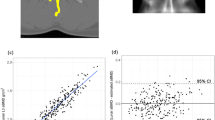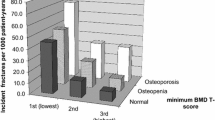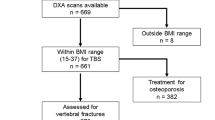Abstract
Summary
In a population-based study, we found that computed tomography (CT)-based bone density and strength measures from the thoracic spine predicted new vertebral fracture as well as measures from the lumbar spine, suggesting that CT scans at either the thorax or abdominal regions are useful to assess vertebral fracture risk.
Introduction
Prior studies have shown that computed tomography (CT)-based lumbar bone density and strength measurements predict incident vertebral fracture. This study investigated whether CT-based bone density and strength measurements from the thoracic spine predict incident vertebral fracture and compared the performance of thoracic and lumbar bone measurements to predict incident vertebral fracture.
Methods
This case-control study of community-based men and women (age 74.6 ± 6.6) included 135 cases with incident vertebral fracture at any level and 266 age- and sex-matched controls. We used baseline CT scans to measure integral and trabecular volumetric bone mineral density (vBMD) and vertebral strength (via finite element analysis, FEA) at the T8 and L2 levels. Association between these measurements and vertebral fracture was determined by using conditional logistic regression. Sensitivity and specificity for predicting incident vertebral fracture were determined for lumbar spine and thoracic bone measurements.
Results
Bone measurements from T8 and L2 predicted incident vertebral fracture equally well, regardless of fracture location. Specifically, for predicting vertebral fracture at any level, the odds ratio (per 1-SD decrease) for the vBMD and strength measurements at L2 and T8 ranged from 2.0 to 2.7 (p < 0.0001) and 1.8 to 2.8 (p < 0.0001), respectively. Results were similar when predicting fracture only in the thoracic versus the thoracolumbar spine. Lumbar and thoracic spine bone measurements had similar sensitivity and specificity for predicting incident vertebral fracture.
Conclusion
These findings indicated that like those from the lumbar spine, CT-based bone density and strength measurements from the thoracic spine may be useful for identifying individuals at high risk for vertebral fracture.

Similar content being viewed by others
Abbreviations
- CT:
-
Computed tomography
- DXA:
-
Dual-energy X-ray absorptiometry
- FEA:
-
Finite element analysis
- vBMD:
-
Volumetric bone mineral density
- VF:
-
Vertebral fracture
References
Burge R, Dawson-Hughes B, Solomon DH, Wong JB, King A, Tosteson A (2007) Incidence and economic burden of osteoporosis-related fractures in the United States, 2005-2025. J Bone Miner Res 22(3):465–475. https://doi.org/10.1359/jbmr.061113
Black DM, Arden NK, Palermo L, Pearson J, Cummings SR (1999) Prevalent vertebral deformities predict hip fractures and new vertebral deformities but not wrist fractures. Study of osteoporotic fractures research group. J Bone Miner Res 14(5):821–828. https://doi.org/10.1359/jbmr.1999.14.5.821
Agten CA, Ramme AJ, Kang S, Honig S, Chang G (2017) Cost-effectiveness of virtual bone strength testing in osteoporosis screening programs for postmenopausal women in the United States. Radiology 285(2):506–517. https://doi.org/10.1148/radiol.2017161259
Khosla S, Shane E (2016) A crisis in the treatment of osteoporosis. J Bone Miner Res 31(8):1485–1487. https://doi.org/10.1002/jbmr.2888
Miller PD (2016) Underdiagnosis and undertreatment of osteoporosis: the battle to be won. J Clin Endocrinol Metab 101(3):852–859. https://doi.org/10.1210/jc.2015-3156
Cosman F, Krege JH, Looker AC, Schousboe JT, Fan B, Sarafrazi Isfahani N, Shepherd JA, Krohn KD, Steiger P, Wilson KE, Genant HK (2017) Spine fracture prevalence in a nationally representative sample of US women and men aged >/=40 years: results from the National Health and Nutrition Examination Survey (NHANES) 2013-2014. Osteoporos Int 28(6):1857–1866. https://doi.org/10.1007/s00198-017-3948-9
Schuit SC, van der Klift M, Weel AE, de Laet CE, Burger H, Seeman E, Hofman A, Uitterlinden AG, van Leeuwen JP, Pols HA (2004) Fracture incidence and association with bone mineral density in elderly men and women: the Rotterdam study. Bone 34(1):195–202. https://doi.org/10.1016/j.bone.2003.10.001
Zhang J, Delzell E, Zhao H, Laster AJ, Saag KG, Kilgore ML, Morrisey MA, Wright NC, Yun H, Curtis JR (2012) Central DXA utilization shifts from office-based to hospital-based settings among Medicare beneficiaries in the wake of reimbursement changes. J Bone Miner Res 27(4):858–864. https://doi.org/10.1002/jbmr.1534
Gausden EB, Nwachukwu BU, Schreiber JJ, Lorich DG, Lane JM (2017) Opportunistic use of CT imaging for osteoporosis screening and bone density assessment: a qualitative systematic review. J Bone Joint Surg Am 99(18):1580–1590. https://doi.org/10.2106/jbjs.16.00749
Chalhoub D, Orwoll ES, Cawthon PM, Ensrud KE, Boudreau R, Greenspan S, Newman AB, Zmuda J, Bauer D, Cummings S, Cauley JA (2016) Areal and volumetric bone mineral density and risk of multiple types of fracture in older men. Bone 92:100–106. https://doi.org/10.1016/j.bone.2016.08.014
Kopperdahl DL, Aspelund T, Hoffmann PF, Sigurdsson S, Siggeirsdottir K, Harris TB, Gudnason V, Keaveny TM (2014) Assessment of incident spine and hip fractures in women and men using finite element analysis of CT scans. J Bone Miner Res 29(3):570–580. https://doi.org/10.1002/jbmr.2069
Wang X, Sanyal A, Cawthon PM, Palermo L, Jekir M, Christensen J, Ensrud KE, Cummings SR, Orwoll E, Black DM, Keaveny TM (2012) Prediction of new clinical vertebral fractures in elderly men using finite element analysis of CT scans. J Bone Miner Res 27(4):808–816. https://doi.org/10.1002/jbmr.1539
Allaire BT, Lu D, Johannesdottir F, Kopperdahl D, Keaveny TM, Jarraya M, Guermazi A, Bredella MA, Samelson EJ, Kiel DP, Anderson DE, Demissie S, Bouxsein ML (2018) Prediction of incident vertebral fracture using CT-based finite element analysis. Osteoporos Int 30:323–331. https://doi.org/10.1007/s00198-018-4716-1
Löffler MT, Jacob A, Valentinitsch A, Rienmüller A, Zimmer C, Ryang Y-M, Baum T, Kirschke JS (2019) Improved prediction of incident vertebral fractures using opportunistic QCT compared to DXA. Eur Radiol 29(9):4980–4989. https://doi.org/10.1007/s00330-019-06018-w
ACR-SPR-SSR (2018) Practice parameters for the performance of musculoskeletal quantitative computed tomography (QCT). American College of Radiology. https://www.acr.org/-/media/ACR/Files/Practice-Parameters/QCT.pdf. Accessed 1 Sept 2019.
Kanis JA, McCloskey EV, Johansson H, Oden A, Melton LJ 3rd, Khaltaev N (2008) A reference standard for the description of osteoporosis. Bone 42(3):467–475. https://doi.org/10.1016/j.bone.2007.11.001
Harris TB, Launer LJ, Eiriksdottir G, Kjartansson O, Jonsson PV, Sigurdsson G, Thorgeirsson G, Aspelund T, Garcia ME, Cotch MF, Hoffman HJ, Gudnason V (2007) Age, gene/environment susceptibility-Reykjavik study: multidisciplinary applied phenomics. Am J Epidemiol 165(9):1076–1087. https://doi.org/10.1093/aje/kwk115
Sigurdsson G, Aspelund T, Chang M, Jonsdottir B, Sigurdsson S, Eiriksdottir G, Gudmundsson A, Harris TB, Gudnason V, Lang TF (2006) Increasing sex difference in bone strength in old age: the age, gene/environment susceptibility-Reykjavik study (AGES-REYKJAVIK). Bone 39(3):644–651. https://doi.org/10.1016/j.bone.2006.03.020
Gudmundsson EF, Gudnason V, Sigurdsson S, Launer LJ, Harris TB, Aspelund T (2012) Coronary artery calcium distributions in older persons in the AGES-Reykjavik study. Eur J Epidemiol 27(9):673–687. https://doi.org/10.1007/s10654-012-9730-6
Genant HK, Wu CY, van Kuijk C, Nevitt MC (1993) Vertebral fracture assessment using a semiquantitative technique. J Bone Miner Res 8(9):1137–1148. https://doi.org/10.1002/jbmr.5650080915
Nevitt MC, Ross PD, Palermo L, Musliner T, Genant HK, Thompson DE (1999) Association of prevalent vertebral fractures, bone density, and alendronate treatment with incident vertebral fractures: effect of number and spinal location of fractures. The fracture intervention trial research group. Bone 25(5):613–619
Anderson DE, Demissie S, Allaire BT, Bruno AG, Kopperdahl DL, Keaveny TM, Kiel DP, Bouxsein ML (2014) The associations between QCT-based vertebral bone measurements and prevalent vertebral fractures depend on the spinal locations of both bone measurement and fracture. Osteoporos Int 25(2):559–566. https://doi.org/10.1007/s00198-013-2452-0
Schousboe JT (2016) Epidemiology of vertebral fractures. J Clin Densitom 19(1):8–22. https://doi.org/10.1016/j.jocd.2015.08.004
Van der Klift M, De Laet CE, McCloskey EV, Hofman A, Pols HA (2002) The incidence of vertebral fractures in men and women: the Rotterdam study. J Bone Miner Res 17(6):1051–1056. https://doi.org/10.1359/jbmr.2002.17.6.1051
Lee DC, Hoffmann PF, Kopperdahl DL, Keaveny TM (2017) Phantomless calibration of CT scans for measurement of BMD and bone strength-inter-operator reanalysis precision. Bone 103:325–333. https://doi.org/10.1016/j.bone.2017.07.029
Budoff MJ, Hamirani YS, Gao YL, Ismaeel H, Flores FR, Child J, Carson S, Nee JN, Mao S (2010) Measurement of thoracic bone mineral density with quantitative CT. Radiology 257(2):434–440. https://doi.org/10.1148/radiol.10100132
Weishaupt D, Schweitzer ME, DiCuccio MN, Whitley PE (2001) Relationships of cervical, thoracic, and lumbar bone mineral density by quantitative CT. J Comput Assist Tomogr 25(1):146–150. https://doi.org/10.1097/00004728-200101000-00027
Mao SS, Li D, Syed YS, Gao Y, Luo Y, Flores F, Child J, Cervantes M, Kalantar-Zadeh K, Budoff MJ (2017) Thoracic quantitative computed tomography (QCT) can sensitively monitor bone mineral metabolism: comparison of thoracic QCT vs lumbar QCT and dual-energy X-ray absorptiometry in detection of age-relative change in bone mineral density. Acad Radiol 24(12):1582–1587. https://doi.org/10.1016/j.acra.2017.06.013
Fang J, Franconeri A, Boos J, Nimhuircheartaigh J, Zhang Z, Brook A, Brook OR (2018) Opportunistic bone density measurement on abdomen and pelvis computed tomography to predict fracture risk in women aged 50 to 64 years without osteoporosis risk factors. J Comput Assist Tomogr 42(5):798–806. https://doi.org/10.1097/RCT.0000000000000744
Lassemillante A-CM, Doi SAR, Hooper JD, Prins JB, Wright ORL (2014) Prevalence of osteoporosis in prostate cancer survivors: a meta-analysis. Endocrine 45(3):370–381. https://doi.org/10.1007/s12020-013-0083-z
Targownik LE, Bernstein CN, Leslie WD (2014) Risk factors and management of osteoporosis in inflammatory bowel disease. Curr Opin Gastroenterol 30(2):168–174. https://doi.org/10.1097/mog.0000000000000037
Engelke K (2017) Quantitative computed tomography-current status and new developments. J Clin Densitom 20(3):309–321. https://doi.org/10.1016/j.jocd.2017.06.017
Pickhardt PJ, Bodeen G, Brett A, Brown JK, Binkley N (2015) Comparison of femoral neck BMD evaluation obtained using lunar DXA and QCT with asynchronous calibration from CT colonography. J Clin Densitom 18(1):5–12. https://doi.org/10.1016/j.jocd.2014.03.002
Bodeen G, Brown J, Brett A (2014) Prospective comparison of QCT BMD measurement using either asynchronous or simultaneous calibration at the femoral neck and lumbar spine. Osteoporos Int 25:S294–S294
Cranney A, Jamal SA, Tsang JF, Josse RG, Leslie WD (2007) Low bone mineral density and fracture burden in postmenopausal women. Can Med Assoc J 177(6):575–580. https://doi.org/10.1503/cmaj.070234
Stone KL, Seeley DG, Lui LY, Cauley JA, Ensrud K, Browner WS, Nevitt MC, Cummings SR (2003) BMD at multiple sites and risk of fracture of multiple types: long-term results from the study of osteoporotic fractures. J Bone Miner Res 18(11):1947–1954. https://doi.org/10.1359/jbmr.2003.18.11.1947
Bauer JS, Henning TD, Müeller D, Lu Y, Majumdar S, Link TM (2007) Volumetric quantitative CT of the spine and hip derived from contrast-enhanced MDCT: conversion factors. AJR Am J Roentgenol 188(5):1294–1301. https://doi.org/10.2214/AJR.06.1006
Kaesmacher J, Liebl H, Baum T, Kirschke JS (2017) Bone mineral density estimations from routine multidetector computed tomography: a comparative study of contrast and calibration effects. J Comput Assist Tomogr 41(2):217–223. https://doi.org/10.1097/rct.0000000000000518
Acu K, Scheel M, Issever AS (2014) Time dependency of bone density estimation from computed tomography with intravenous contrast agent administration. Osteoporos Int 25(2):535–542. https://doi.org/10.1007/s00198-013-2440-4
Acknowledgments
The researchers are indebted to the participants for their willingness to participate in the study.
Funding
This study has been funded by National Institutes of Health (NIH) contract N01-AG-1-2100, NIH grant R01 AR053986 and R44 AR052234; the NIA Intramural Research Program, Hjartavernd (the Icelandic Heart Association); and the Althingi (the Icelandic Parliament). The contents are solely the responsibility of the authors and do not necessarily represent the views of the NIH.
Author information
Authors and Affiliations
Corresponding author
Ethics declarations
Written informed consent was obtained from all participants at the time of data collection, and the study was approved by the Icelandic National Bioethics Committee and by the Institutional Review Boards of Boston University Medical Center, Beth Israel Deaconess Medical Center, and Hebrew SeniorLife.
Conflicts of interest
FJ, BA, SS, MAB, DEA, EJS, DPK, TBH, VGG, and MLB declare that they have no conflict of interest. DLK is an employee of O.N. Diagnostics and has a financial interest in O.N. Diagnostics. TMK has received consulting fees from Amgen and O.N. Diagnostics, and has a financial interest in O.N. Diagnostics. DPK has received grant funding from Radius Health and the National Dairy Council, and serves on a scientific advisory board for Solarea Bio. He also received royalties for publication by Wolters Kluwer for contributions to UpToDate.
Additional information
Publisher’s note
Springer Nature remains neutral with regard to jurisdictional claims in published maps and institutional affiliations.
Electronic supplementary material
ESM 1
(DOCX 117 kb)
Rights and permissions
About this article
Cite this article
Johannesdottir, F., Allaire, B., Kopperdahl, D. et al. Bone density and strength from thoracic and lumbar CT scans both predict incident vertebral fractures independently of fracture location. Osteoporos Int 32, 261–269 (2021). https://doi.org/10.1007/s00198-020-05528-4
Received:
Accepted:
Published:
Issue Date:
DOI: https://doi.org/10.1007/s00198-020-05528-4




